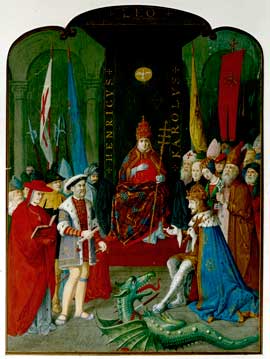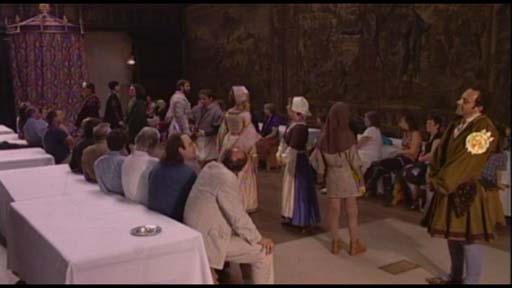Political History of 1532 / 33
Professor Tom Betteridge

King Henry VIII, Charles V and Leo X
The two key events that occurred in the period 1532 / 33 were the rapprochement between France and England, and Anne Boleyn’s pregnancy. The former created the possibility that Henry VIII’s struggle with the papacy could be resolved without a final break with Rome, the latter ensured that this was not the case.
The growing friendship between England and France during the course of 1532 ultimately resulted in a meeting between Henry and Francis in October 1532 at Boulogne and Calais. This trip was also significant since Henry was accompanied by Anne. It is interesting to note that weather played an important part in the trip to and from France – it was a source of anxiety and storms and fog prevented Henry from crossing back to England on schedule. A key aim of the meeting between the two kings was for Henry to secure Francis’ support in his struggle with the papacy. In particular, Henry hoped to be able to use the on-going negotiations between Francis and the Pope Clement over the marriage of Francis’ second son and the pope’s niece, Catherine de Medici, to secure papal blessing or at least tolerance for his relationship with Anne.
Of course this did not happen since the other key event of this period was the secret marriage between Henry and Anne on the 25th January necessitated by Anne’s pregnancy. Once Anne was pregnant Henry had to move quickly and decisively to ensure that the child would be legitimate. It is, however, important to pause for a moment and to consider what would have happened if Henry had been able to reach an agreement with the Pope in 1532 / 33. Like George Bernard, I find it hard to believe that Henry would ever have tolerated a real restoration of papal authority. He saw himself as a reforming monarch who had a duty to purge the English church of superstition and corruption. At the same time it is of course possible that a compromise could have been agreed between Henry and the papacy which allowed both sides to claim victory. Having secured the submission of the clergy, and married Anne, Henry had what he wanted. The problem was that Anne’s pregnancy forced Henry’s hand and meant he had to proceed with an English solution to his ‘Great Matter’. He did not have time to wait for the slow wheels of European diplomacy.
It is worthwhile in terms of the historical context of The Play of the Weather to look in a little more detail at the chronology of the period during which it was probably written.
| 1st September | Windsor - Henry confers the title of Marquis of Pembroke on Anne at Windsor. Henry and Anne at Greenwich |
| 10th October | Henry and Anne in Dover accompanied by 2,000 courtiers, servants etc. |
| 11th October | Henry on board the ship Swallow sails to Calais. |
| 20th October | Henry and Francis meet. Henry then returns with Francis to Boulogne. |
| 25th October | Henry and Francis ride to Calais where Francis spends five days. On the 27th October there was a mask of ladies. After supper came in the Marchioness of Pembroke, with vii ladies in Masking apparel, of strange fashion, made of clothe of gold, compassed with Crimson Tinsel Satin, owned with Clothe of Silver, lying lose and knit with laces of Gold: these ladies were brought into the chamber, with four demoiselles apparelled in Crimson satin, with Tabards of fine Cypress: the lady Marques took the French Kyng, and the Countess of Darby, took the Kyng of Nauerr, and euery Lady took a lord, and in dancing the kyng of England, took away the ladies visors, so that there the ladies beauties were shewed, and after they had danced a while they ceased, and the French Kyng talked with the Marchioness of Pembroke a space. & then he took his leave of the ladies, and the kyng conveying hym to his lodging ... (The manner of the triumph at Calais and Boulogne). |
| 30th October | The meeting between Francis and Henry ends. |
| 11th November | Henry returns to England having been kept in Calais by bad weather, in particular storms and fogs. It took Henry and Anne 12 days to travel from Dover to Greenwich. In this period they spend a day at Sittingbourne and a day at Stone. There are also two days when we are unsure where they were (21st and 22nd November). This is relatively usual. |
| December | Anne conceives. Hall's Chronicle notes that Henry kept the Christmas season of 1532 - 1533 at Greenwich, but gives no details of the entertainments, revels or masks. 25th January - Henry and Anne secretly married. |
| 25th January | Henry and Anne secretly married. |
There are a number of important points to make about this chronology in relation to The Play of the Weather, in particular as regards the play’s possible performance at court but not in front of Henry during Christmas 1532 / 33. The first point to make is that there is evidence that there was anxiety in this period over the king’s absence. In the autumn of 1532 two editions were produced of the work entitled, The manner of the triumph at Calais and Boulogne. What is interesting about these editions is how similar they are. One minor change is the addition on the back of the title page of the second edition of a page listing, ‘The names of the noble men of France’. The rest of the changes take the form of slightly more detail concerning the various events and jousts that took place. There appears to be no real or substantial agenda being pursued in either of the two editions beyond a concern that all the details of the meeting between the monarchs were properly recorded.
It is, however, possible that Henry’s relatively long absence from court was the motivation for producing two editions of The manner of the triumph at Calais and Boulogne. And it may be that The Play of the Weather was also designed at least in part to address the King’s trip to France and his return with Anne. Merry Report’s explanation to The Gentlewoman for why Jupiter cannot see her, the ‘new moon' speech, contains a number of important not very subtle references to Henry’s marital affairs.
Merry Report: By my fayth, for his lordship is ryght besy
Wyth a pece of work that nedes must be done.
Even now is he makynge of a new moone:
He sayth your old moones be so farre tasted
That all the goodness of them is wasted;
Whyche of the great wete hath ben moste mater,
For olde moones be leake, they can holde no water.
But for this new mone, I durst lay my gowne
Except a few droppes at her goynge downe,
Ye get no rayne tyll her arysynge
Without yt nede, and then no mans devysynge
Coulde wyshe the fashion of rayne to be so good:
Not gushynge out lyke gutters of Noyes flood,
But smale droppes sprynklyng softly on the grounde:
Though they fell on a sponge they wold gyve no sounde.
This new moone shal make a thing spryng more in this while
Than a old moon shal while a mile go a mile. (793-809)
Video 1 : Tom Betteridge and Eleanor Rycroft discussing the 'New Moon' speech
Merry Report’s speech fills the space of the court with bawdy jokes, not only about the ‘tightness’ of the new moon compared with the leakiness of the old but also with references to Catherine’s miscarriages (the old moon cannot contain its water but instead lets it gush out in too great quantities and before its time) and to Henry’s sexual prowess (the new moon will make a ‘thing’ spring’). The reference to Jupiter making a new moon may be a reference to Anne’s pregnancy with the shape of the new moon relating to her pregnant body. It is possible that in this speech Merry Report is telling the court that Anne is pregnant and confirming in its misogyny Catherine’s complete downfall. We know from Lodovico Spinelli’s account of the Greenwich revels of 1527 that court entertainments often combined didactic and comic material with specific and detailed topical allusions. The court as an audience of revels and interludes was practiced in adopting different interpretative strategies for aspects of the same entertainment. Indeed as was the case in 1527, it was often quite clear which aspects of a court performance or event were meant to be simply enjoyed and which had a specific political charge.
See Videos 1 & 2 for more discussion of the New Moon Speech.
Video 2 : Greg Walker on the 'New Moon' speech
It is important to note, however, that Merry Report’s bawdy response to Jupiter’s trouble with his moons can also be seen as an aspect of Heywood’s religious conservatism. One implication of the crucial role that Merry Report has in The Play of the Weather is that all the strife produced by the debate over the weather, in other words Henry’s ‘Great Matter’, is really a category mistake; a simple fact of human life, the changeability of the weather, has been mistaken for something much more serious and intractable. The Play of the Weather is ultimately a plea for moderation and Merry Report is Heywood’s spokesman for a world of English humour that was in danger of being drowned out by those demanding their weather take precedence over everyone else’s. Merry Report is, of course, indifferent to the weather – it’s all one to him.
References:
The manner of the triumph at Calais and Boulogne (London, 1532).











